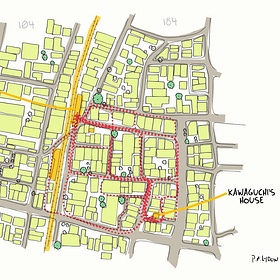What would a city designed by kids look like? Would their designs be insightful, creative, or just plain ridiculous? I found out at least some answers this past week, in a small kids classroom looking out over a permaculture garden near Kobe, Japan.
—
I work with the headmaster Kaori Tsuji and a handful of kids. They spend part of the afternoon with their hands in the soil, chasing down dango mushi — we used to call them roly poly when I was a kid — and harvesting garlic.
Later, they eat nutritious food, a miso pizza with some ingredients from their garden. We toss a ball around for a bit, and then they call me an oni — a Japanese Ogre — and ask me to chase them. I oblige, until realizing kids are faster and more agile than this ogre. Later, after all the action, we are back inside with a small whiteboard, and I ask them a question.
“We are going to draw a city. What should be in it?”
I draw a landscape similar to the one we are in, mountains and a river, meandering down into the sea. Then, the kids help me fill in the rest.
We start with a train station — this is Japan after all — and then Trees. Boats. Houses. Apartments. Cats. Giant cats. More giant cats. A car. A drug store. A pier and sea vessels. A school. A giant clown. A park with play structures, and a zoo with a new panda being airlifted in from China by helicopter — the much loved panda at the Kobe Zoo recently died of old age.
Other than the giant cats and clown, the ingredients are not all that uncommon. As we move on in the drawing, it is the arrangement of these ingredients that becomes interesting.
Here is the whiteboard drawing from this class session, produced mostly at the command of the children…
The arrangement of this city was so interesting, that we seemed to invent a few new ‘urban planning codes’ with the kids, who deemed that:
Some slides in the park start should start at the tops of the nearby apartments and end in the park, allowing direct access to the park via slide.
As these slides seem to work well for moving people to the park, there should also be a slide installed between the shopping mall and train station. Then, after a long day of shopping, one can slide directly into the station to catch their train.
Cars are allowed in the city, but they are boring, so every car in the city should be a Transformer.
It is dumb to have a neighborhood without a train station. If you build a neighborhood, it is required that there should be a train station.
Giant cats need friends, but not just other cat friends. Thus, there should also be a giant clown who can be friends with the cats.
Other than the giant clown, I generally understand most of the demands from these kids. After our city design is finished, I ask everyone to pick where they want to live. They are a diverse bunch. The first chooses the apartment with the slide, the next picks the house by the mountain, another picks the boat in the harbor, and finally the ‘cat land’ apartment complex with the clown outside — chosen by the kid who demanded the clown, although it is worth noting that everyone else thinks it is too scary to have a giant clown outside of your apartment. I agree.
With the small sample size, I am not quite sure we can definitively answer any questions. There is a lot of creativity here, and bit of ridiculousness. On the other hand, I would basically favor the idea of living in a city where you can take the slide from your apartment to the park — or the train station. That just sounds like too much fun to pass up.
Which makes me think that we should probably hire some kids as assistant urban planners, and then seriously consider how to make a few of their wild ideas into reality.
After all, some of these ideas are not so crazy. As evidenced by the giant slide I once saw in the Korean city of Busan. It takes one from the library, down the mountain, to the playground below.
Yes. I rode it. Although this Oni’s hips were a bit too wide to make that turn in the middle. Back to the drawing board.
A big thank you to Kaori Tsuji and New Earth Kids for hosting a space for creativity and openness for these children. And for always welcoming me to do projects together.
Thanks for joining me here, and for being subscribers. I am glad you are here. If you want to help propel this project, you can share it with others, or become a free subscriber if you are not already. Finally, if you are doing all of that, and you have a few dollars a month to put towards The Possible City, then I welcome you to join the ranks of our illustrious, paid subscribers!
If you liked this story, you’ll probably also dig this one from last year…
SHORT #26: Kawaguchi and the Oden Route
Hey everyone. I am planning in the months to come, a series the looks into the daily lives of people in very specific kinds of urban places. To begin this series, I have taken the liberty of hand drawing for you, a map of what we’ll call “Kawaguchi’s neighborhood.” Kawaguchi is our first character. Exploring this map a bit might enhance your enjoyment o…









